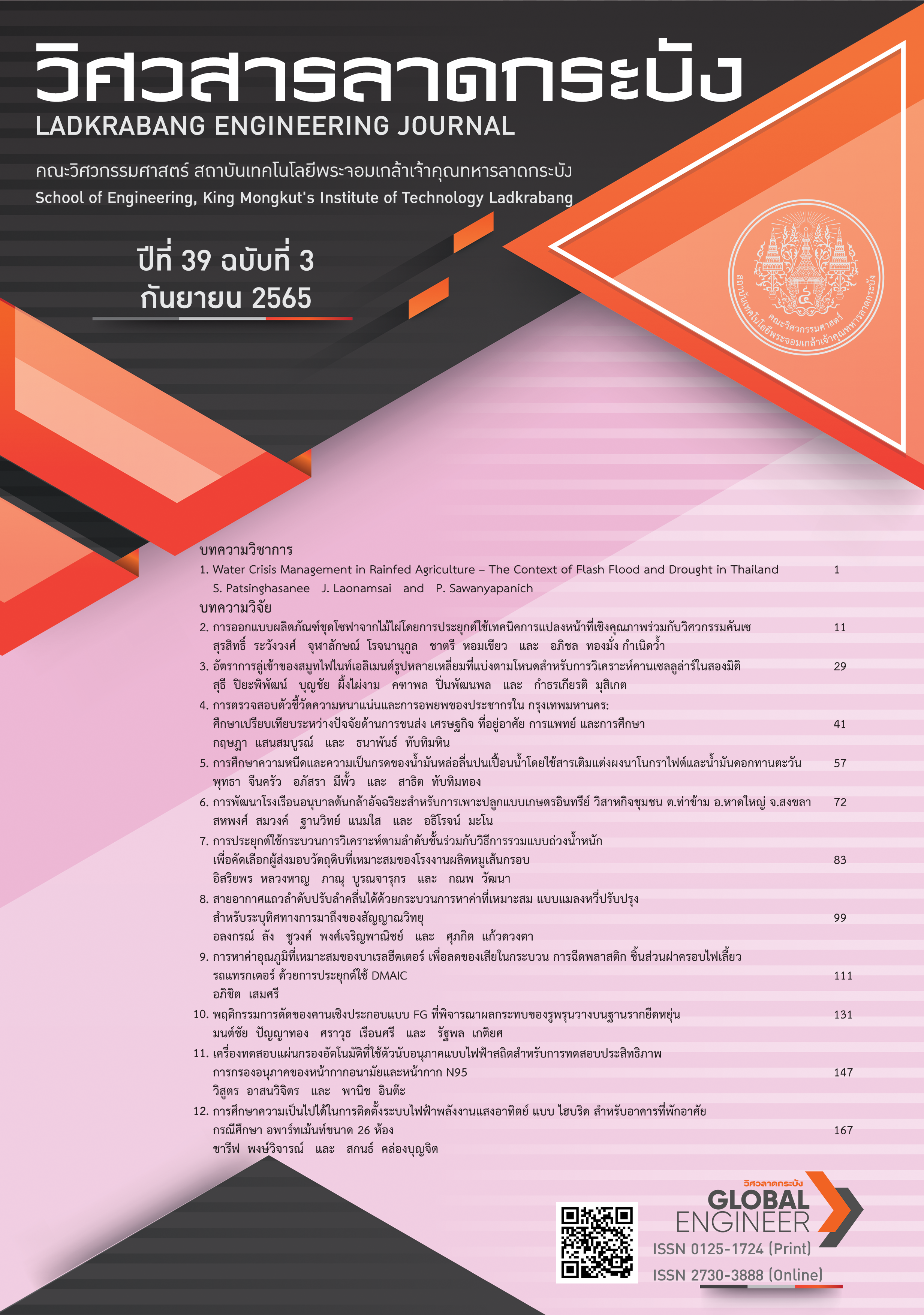เครื่องทดสอบแผ่นกรองอัตโนมัติที่ใช้ตัวนับอนุภาคแบบไฟฟ้าสถิตสำหรับการทดสอบประสิทธิภาพการกรองอนุภาคของหน้ากากอนามัยและหน้ากาก N95
คำสำคัญ:
โควิด-19, เครื่องทดสอบตัวกรอง, ประสิทธิภาพการกรอง, หน้ากากอนามัย, หน้ากากกรองอากาศบทคัดย่อ
จุดมุ่งหมายของการศึกษานี้คือการพัฒนาและประเมินเครื่องทดสอบตัวกรองอัตโนมัติโดยอิงจากตัวนับจำนวนอนุภาคแบบไฟฟ้าสถิตเพื่อหาค่าการผ่านทะลุหรือประสิทธิภาพของตัวกรองและความดันตกของหน้ากากอนามัยและหน้ากาก N95 ต้นแบบของเครื่องทดสอบตัวกรองอัตโนมัติถูกสร้างขึ้นตามมาตรฐาน มอก. 2424-2562 และ มอก. 2480-2562 และทำการทดสอบเชิงการทดลองต้นแบบเครื่องทดสอบตัวกรองที่พัฒนาขึ้นประกอบด้วยแหล่งกำเนิดอนุภาคละอองลอย ตัวทำให้อนุภาคเป็นกลาง ตัวทำความร้อนอากาศ ถังผสม ห้องทดสอบ ตัวนับจำนวนอนุภาค ตัววัดความดันแตกต่าง ตัวอัดอากาศ ตัววัดอัตราการไหล และชุดประมวลผลและแสดงผลการทดสอบ ในเครื่องทดสอบตัวกรองที่พัฒนาขึ้นอนุภาค PSL และ NaCl สามารถสร้างขึ้นด้วยความเข้มข้นเชิงจำนวนตั้งแต่ 1 ถึง 20,000 particles/cm3 โดยเครื่องทดสอบตัวกรองที่พัฒนาขึ้นได้รับการออกแบบมาให้ทำงานที่อัตราการไหลของอนุภาคทดสอบที่ประมาณ 5 ถึง 100 L/min ที่ประสิทธิภาพการกรองอนุภาคสูงถึง 99.999% ในการศึกษานี้ได้เปรียบเทียบประสิทธิภาพการกรองอนุภาคจากเครื่องทดสอบตัวกรองที่พัฒนาขึ้นกับผลที่ได้จากเครื่องทดสอบตัวกรองที่ใช้เทคนิคการนับอนุภาคแบบกระเจิงแสง และจากการเปรียบเทียบพบว่ามีค่าใกล้เคียงกัน มีความแตกต่างของประสิทธิภาพการกรองอนุภาค PSL ขนาด 0.1 µm และ อนุภาคเกลือขนาด 0.264 µm ระหว่างเครื่องทดสอบตัวกรองที่พัฒนาขึ้นกับเครื่องทดสอบตัวกรองที่ใช้เทคนิคการนับอนุภาคแบบกระเจิงแสงประมาณ 0.35% และ-0.47% ตามลำดับ ทำให้เห็นว่าต้นแบบที่พัฒนาขึ้นสามารถใช้เป็นเครื่องทดสอบตัวกรองแบบอัตโนมัติได้และการทดสอบต้นแบบเครื่องทดสอบตัวกรองที่พัฒนาขึ้นแสดงให้เห็นผลที่ดีในการหาค่าการผ่านทะลุหรือประสิทธิภาพการกรองของอนุภาคและความดันตกของหน้ากากอนามัยและหน้ากาก N95
References
COVID-19 situation report, Department of Disease Control, May. 18, 2021. [Online]. Available: https://covid19.ddc.moph.go.th/
K. O’Dowd, K. M. Nair, P. Forouzandeh, S. Mathew, J. Grant, R. Moran, J. Bartlett, J. Bird and S. C. Pillai, “Face Masks and Respirators in the Fight Against the COVID-19 Pandemic: A Review of Current Materials, Advances and Future Perspectives,” Materials, vol. 13, no. 15, 2020, Art. no. 3363, doi: 10.3390/ma13153363.
N. El-Atab, N. Qaiser, H. Badghaish, S. F. Shaikh and M. M Hussain, “Flexible Nanoporous Template for the Design and Development of Reusable Anti-COVID-19 Hydrophobic Face Masks,” ACS Nano, vol. 14, no. 6, pp. 7659–7665, 2020, doi:10.1021/acsnano.0c03976.
E. E Sickbert-Bennett, J. M. Samet, P. W. Clapp, H. Chen, J. Berntsen, K. L. Zeman, H. Tong, D. J. Weber and W. D. Bennett, “Filtration Efficiency of Hospital Face Mask Alternatives Available for Use During the COVID-19 Pandemic,” JAMA Internal Medicine, vol. 180, no. 12, pp.1607–1612, 2020, doi: 10.1001/jamainternmed.2020.4221.
A. Konda, A. Prakash, G. A. Moss, M. Schmoldt, G. D. Grant and S. Guha, “Aerosol Filtration Efficiency of Common Fabrics Used in Respiratory Cloth Masks,” ACS Nano, vol. 14, no. 5, pp.6339–6347, 2020, doi: 10.1021/acsnano.0c03252.
O. Aydin, B. Emon, S. Cheng, L. Hong, L. P. Chamorro and M. T. A. Saif, “Performance of Fabrics for Home-made Masks Against the Spread of COVID-19 through Droplets: A Quantitative Mechanistic Study,” Extreme Mechanics Letters, vol. 40, 2020, Art. no.100924, doi: 10.1016/ j.eml.2020.100924.
S. Rengasamy, B. Eimer and R. E. Shaffer, “Simple Respiratory Protection—Evaluation of the Filtration Performance of Cloth Masks and Common Fabric Materials Against 20–1000 nm Size Particles,” The Annals of Occupational Hygiene, vol. 54, no. 7, pp.789–798, 2010, doi: 10.1093/annhyg/meq044.
H. Whiley, T. P. Keerthirathne, M. A. Nisar, M. A. F. White and K. E. Ross, “Viral Filtration Efficiency of Fabric Masks Compared with Surgical and N95 Masks,” Pathogens, vol. 9, no. 9, 2020, Art. no. 762, doi: 10.3390/pathogens9090762.
C. M. Dugdale and R. P. Walensky, “Filtration Efficiency, Effectiveness, and Availability of N95 Face Masks for COVID-19 Prevention,” JAMA Intern Medicine, vol. 180, no. 12, pp.1612–1613, 2020, doi: 10.1001/jamainternmed.2020.4218.
P. Intra, “Filtration Efficiency of Surgical Masks, Fabric Masks and N95/KN95/FFP1/FFP2 Masks Available for Use during the COVID-19 Pandemic in Thailand,” Thai Science and Technology Journal (TSTJ), vol.29, no.5, pp.904–918, 2021.
Automated Filter Tester Model 8130A, TSI Inc., Jan. 12, 2022. [Online]. Available: https://tsi.com/products/filter-testers/automated-filter-tester-8130a/
Automated Filter Tester Model 3160, TSI Inc., Jan. 12, 2022. [Online]. Available: https://tsi.com/ products/filter-testers/automated-filter-tester-3160/
G506 Mask Automatic Filter Performance Tester, Qinsun Instruments Co., Ltd., Jan. 12, 2022. [Online]. Available: http://www.testerinlab.com/products/Others/2018/0316/200.html
42 CFR Part 84 Respiratory Protective Devices, National Institute for Occupational Safety and Health , Mar. 4, 1997. [Online]. Available: https://www.cdc.gov/niosh/npptl/topics/respirators/pt84abs2.html
Standard Test Method for Determining the Initial Efficiency of Materials Used in Medical Face Masks to Penetration by Particulates Using Latex Spheres, ASTM F2299/F2299M-03(2017), ASTM International, West Conshohocken, PA. USA, 2017.
Standard Specification for Performance of Materials Used in Medical Face Masks, ASTM F2100-19e1, ASTM International, West Conshohocken, PA, USA, 2019.
B. Y. H. Liu and D. Y. H. Pui, “Equilibrium bipolar charge distribution of aerosols,” Journal of Colloid and Interface Science, vol.49, no.2, pp.305–312, 1974, doi:10.1016/0021-9797(74)90366-X.
P. Intra and N. Tippayawong, “Performance evaluation of an electrometer system for ion and aerosol charge measurements,” Korean Journal of Chemical Engineering, vol.28, no.2, pp.527–530, 2011, doi: 10.1007/s11814-010-0378-1.
P. Intra, A. Yawootti and N. Tippayawong, “An electrostatic sensor for continuous monitoring of particulate air pollution,” Korean Journal of Chemical Engineering, vol. 30, no. 12, pp. 2205–2212, 2013, doi: 10.1007/s11814-013-0168-7.
P. Intra and N. Tippayawong, “Development and evaluation of a Faraday cup electrometer for measuring and sampling atmospheric ions and charged aerosols,” Particulate Science and Technology, vol. 33, no. 3, pp. 257–263, 2015, doi:10.1080/02726351.2014.952392.
P. Intra, V. Asanavijit and W. Rattanachan, “Evaluation of the Particle Filtration Efficiency of Surgical Masks by Electrostatic and Light Scattering Particle Counters,” Ladkrabang Engineering Journal, vol.39, no. 2, pp. 53–69, 2022.
K. Willeke and P. A. Baron, “Filter collection,” in Aerosol Measurement: Prnciples, Techniques, and Applications, New York, USA: John Wiley & Sons, 1993, ch. 10, pp. 179–205.
P. Intra, and N. Tippayawong, “Experimental characterization of a short electrical mobility spectrometer for aerosol size classification,” Korean Journal of Chemical Engineering, vol. 26, no. 6, pp. 1770–1777, 2009, doi: 10.1007/s11814-009-0261-0.
P. Intra, and N. Tippayawong, “Development of a fast-response, high-resolution electrical mobility spectrometer,” Korean Journal of Chemical Engineering, vol. 28, no. 1, pp. 279–286, 2011, doi: 10.1007/s11814-010-0326-0.
Downloads
เผยแพร่แล้ว
How to Cite
ฉบับ
บท
License
Copyright (c) 2022 คณะวิศวกรรมศาสตร์ สถาบันเทคโนโลยีพระจอมเกล้าเจ้าคุณทหาร

This work is licensed under a Creative Commons Attribution-NonCommercial-NoDerivatives 4.0 International License.
บทความที่ได้รับการตีพิมพ์เป็นลิขสิทธิ์ของคณะวิศวกรรมศาสตร์ สถาบันเทคโนโลยีพระจอมเกล้าเจ้าคุณทหารลาดกระบัง
ข้อความที่ปรากฏในบทความแต่ละเรื่องในวารสารวิชาการเล่มนี้เป็นความคิดเห็นส่วนตัวของผู้เขียนแต่ละท่านไม่เกี่ยวข้องกับสถาบันเทคโนโลยีพระจอมเกล้าเจ้าคุณทหารลาดกระบัง และคณาจารย์ท่านอื่นๆในสถาบันฯ แต่อย่างใด ความรับผิดชอบองค์ประกอบทั้งหมดของบทความแต่ละเรื่องเป็นของผู้เขียนแต่ละท่าน หากมีความผิดพลาดใดๆ ผู้เขียนแต่ละท่านจะรับผิดชอบบทความของตนเองแต่ผู้เดียว






